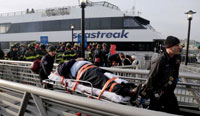 On January 9, 2013, we posted about the Seastreak Wall Street catamaran ferry, which slammed into a loading barge at Pier 11 in New York City’s East River in Lower Manhattan at 12 knots, injuring 80 of the 331 passengers and crew. The 140 feet long and 30 feet wide ferry was operating on scheduled service from Atlantic Highlands and Conners Highlands in New Jersey to Lower Manhattan. The National Transportation Saftey Board (NTSB) recently released its findings on the accident, which found that the action was caused the captain losing control of the ferry as it approached the dock, complicated by poor bridge design and lax management over-site of ferry operations.
On January 9, 2013, we posted about the Seastreak Wall Street catamaran ferry, which slammed into a loading barge at Pier 11 in New York City’s East River in Lower Manhattan at 12 knots, injuring 80 of the 331 passengers and crew. The 140 feet long and 30 feet wide ferry was operating on scheduled service from Atlantic Highlands and Conners Highlands in New Jersey to Lower Manhattan. The National Transportation Saftey Board (NTSB) recently released its findings on the accident, which found that the action was caused the captain losing control of the ferry as it approached the dock, complicated by poor bridge design and lax management over-site of ferry operations.
When the ferry, was en-route the captain noticed a vibration as they passed under the Verrazano-Narrows Bridge. The captain suspected that something might have fouled one of the two controllable pitch propellers. He shifted from automatic propeller control to a backup system that allowed manual control of the propellers’ pitch. Unfortunately, when the ferry approached the dock, the captain had forgotten that the propulsion system was still in the backup manual mode. When he attempted to slow the ferry, the controllable pitch blades on the propellers did not reverse. This coincided with the captain switching from a centerline bridge control to a starboard station, so that he would have better visibility for docking. When the ferry did not slow, the captain misdiagnosed the problem and thought that he had not transferred the controls. In the intervening seconds, the ferry hit the dock at speed.
The NTSB was critical of the bridge design which did not make it sufficiently evident in which mode the propulsion system was operating. The board was also critical of Seastreak’s management and oversight of vessel operations. They noted that “the Seastreak Wall Street operations manual had not been updated since the ferry was converted in July 2012 from waterjet to controllable pitch propeller (CPP) propulsion.” They also found that “the transfer of control from one bridge station to another was a critical point in the vessel’s approach, but no formal company guidance was available for executing this procedure.” The NTSB also noted that the most severe passenger injuries were related to passengers being knocked down stairways by the crash. They noted: “Seastreak ferry crewmembers were not directed to control passenger access to stairwells, even when approaching a landing, nor were they required to make a passenger safety announcement upon arrival.”

The NTSB has a tendancy to cast their opinion when this is a matter of fact. and the facts are that the master put the vessel in Back up silenced the audible alarms brought the vessel engines up to 100% load which increased the vessel speed by 2 knots(does this sound like a logical way to shake something from the wheels? Use your imagination and figure out why he did that.). Arrived at the dock did not pick up on the unusual response of the vessel and did not pay attention to the indication system. There are a million things that could have been done in hind sight that may have prevented the problem. Key word may.